Aerodynamic Evolution: Contrasting F1 and F2 Racing
Formula 1 (F1) and Formula 2 (F2) are two prominent categories of open-wheel motorsport, each known for its unique style of racing. Aerodynamics are a fundamental aspect of both series, but they differ significantly in their approach and objectives.
In this article, we will explore the key differences in aerodynamics between F1 and F2 racing.
The Fundamental Differences
Purpose and Racing Philosophy:
Formula 1: F1 is widely regarded as the pinnacle of motorsport, characterised by cutting-edge technology, innovation, and a relentless pursuit of speed and performance. The core philosophy of F1 is to push the boundaries of engineering excellence, where aerodynamics play a crucial role in achieving the fastest lap times and race victories. Teams invest extensively in research and development to gain a competitive edge in the highly competitive world of F1.
Formula 2: F2 serves as a feeder series to F1, nurturing young and talented drivers on their journey to the pinnacle of motorsport. While F2 maintains a high level of competition, the series places greater emphasis on driver skill and racecraft than on advanced aerodynamic development. F2 cars are designed to provide a platform for emerging talents to showcase their abilities, focusing on close and thrilling racing rather than outright top speeds. F2 is a spec series, meaning all cars are the same. Built on the 2018 Dallara F2 chassis, teams can set the cars up, but unlike F1, they do not 'build' the cars from scratch.
Key Differences in Aerodynamics
Downforce vs. Minimalism:
Formula 1: F1 cars are known for their intricate and extensive aerodynamic features designed to generate substantial downforce. Downforce is a vertical force created by the interaction of the car's bodywork and wings with the airflow, pressing the car onto the track and enhancing grip and stability. F1 teams aim to maximise downforce while minimising drag, allowing the cars to corner at high speeds.
Formula 2: F2 cars prioritise simplicity and minimalism in their aerodynamic design. While they still generate downforce to aid cornering, the level of complexity is significantly lower than that of F1 cars. The primary focus in F2 is on providing a level playing field for drivers, promoting overtaking opportunities, and ensuring that driver skill remains a deciding factor in races.
Shape and Complexity:
Formula 1: F1 cars feature intricate and variable aerodynamic components, including complex front and rear wings, bargeboards, and diffusers. These components are designed to manipulate airflow precisely, creating downforce and reducing turbulence. The aerodynamic design of F1 cars is highly detailed and sophisticated, reflecting the advanced engineering behind them.
Formula 2: F2 cars are characterised by cleaner lines and simpler aerodynamic elements. The goal is to provide a balanced and predictable driving experience without excessively complex aerodynamics. The design is intended to reduce turbulence and promote stable racing rather than fostering a reliance on aerodynamic grip.
Weight Distribution:
Formula 1: F1 teams meticulously engineer aerodynamics to maintain precise weight distribution, a critical factor for handling and overall performance. Weight distribution significantly influences how the car behaves during cornering, under braking, and during acceleration. Achieving an optimal balance is crucial for F1 cars.
Formula 2: While weight distribution remains important in F2, the series places less emphasis on precise weight balance compared to F1. The aim is to provide a more versatile and adaptable car for young drivers, allowing them to focus on developing their driving skills without the complexities of fine-tuning weight distribution.
Circuit Types:
Formula 1: F1 solely race on FIA Grade 1 circuits and street tracks, featuring a mix of tight corners, high-speed straights, and technical sections. The aerodynamics of F1 cars are meticulously optimised for high-speed performance, agility in corners, and efficient airflow management to minimise drag.
Formula 2: F2 solely race on F1 circuits as a support category in a typical F1 weekend. Of course, the cars have less extreme aerodynamic demands. The focus is on providing a balanced and competitive racing platform where drivers can hone their skills and showcase their talents. The aerodynamics of F2 cars are designed to ensure that driver skill remains paramount.
Formula 1 and Formula 2 racing are two distinct categories within the world of open-wheel motorsport, each with its own set of objectives and design philosophies regarding aerodynamics. F1 places a strong emphasis on engineering excellence, advanced aerodynamics, and extreme speed, while F2 prioritises driver skill and close, competitive racing. These differences in aerodynamics not only define the character of each series but also contribute to the unique appeal and excitement of both categories for motorsport enthusiasts around the world.




.png)





















